Menu Justification Report: Design, Costing & Pricing Analysis
VerifiedAdded on 2023/06/12
|9
|2083
|458
Report
AI Summary
This report provides a justification for a prepared menu, addressing various factors crucial in the culinary and hospitality industry. It emphasizes the importance of pricing strategies, considering aspects such as market price points, menu item costing, and required gross profit. The menu design includes a range of foods like salads, nachos, appetizers, soups, and sandwiches, with prices ranging from $1.5 to $10, making it affordable for the Lorne community. The report highlights the significance of market considerations, high-value food offerings, and unique selling propositions to attract customers. It also discusses the use of cost percentages, ingredient costs, and inventory programs to determine menu pricing, along with the calculation of gross profit based on customer preferences and financial status. The report concludes by emphasizing the goal of increasing actual gross profit by controlling expenses and achieving financial targets, making it a valuable resource for culinary management students. Desklib provides access to this and many other solved assignments for students.
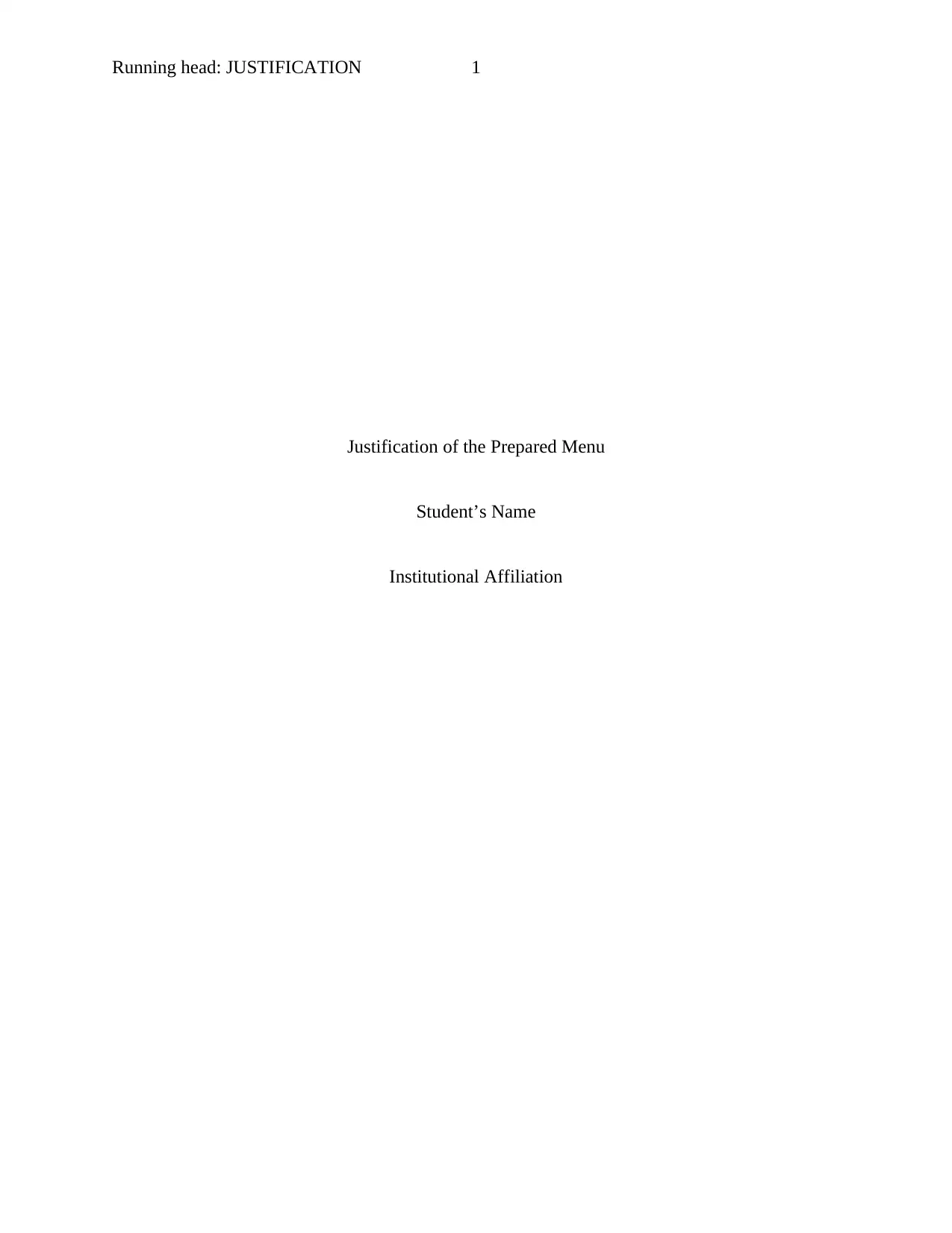
Running head: JUSTIFICATION 1
Justification of the Prepared Menu
Student’s Name
Institutional Affiliation
Justification of the Prepared Menu
Student’s Name
Institutional Affiliation
Paraphrase This Document
Need a fresh take? Get an instant paraphrase of this document with our AI Paraphraser
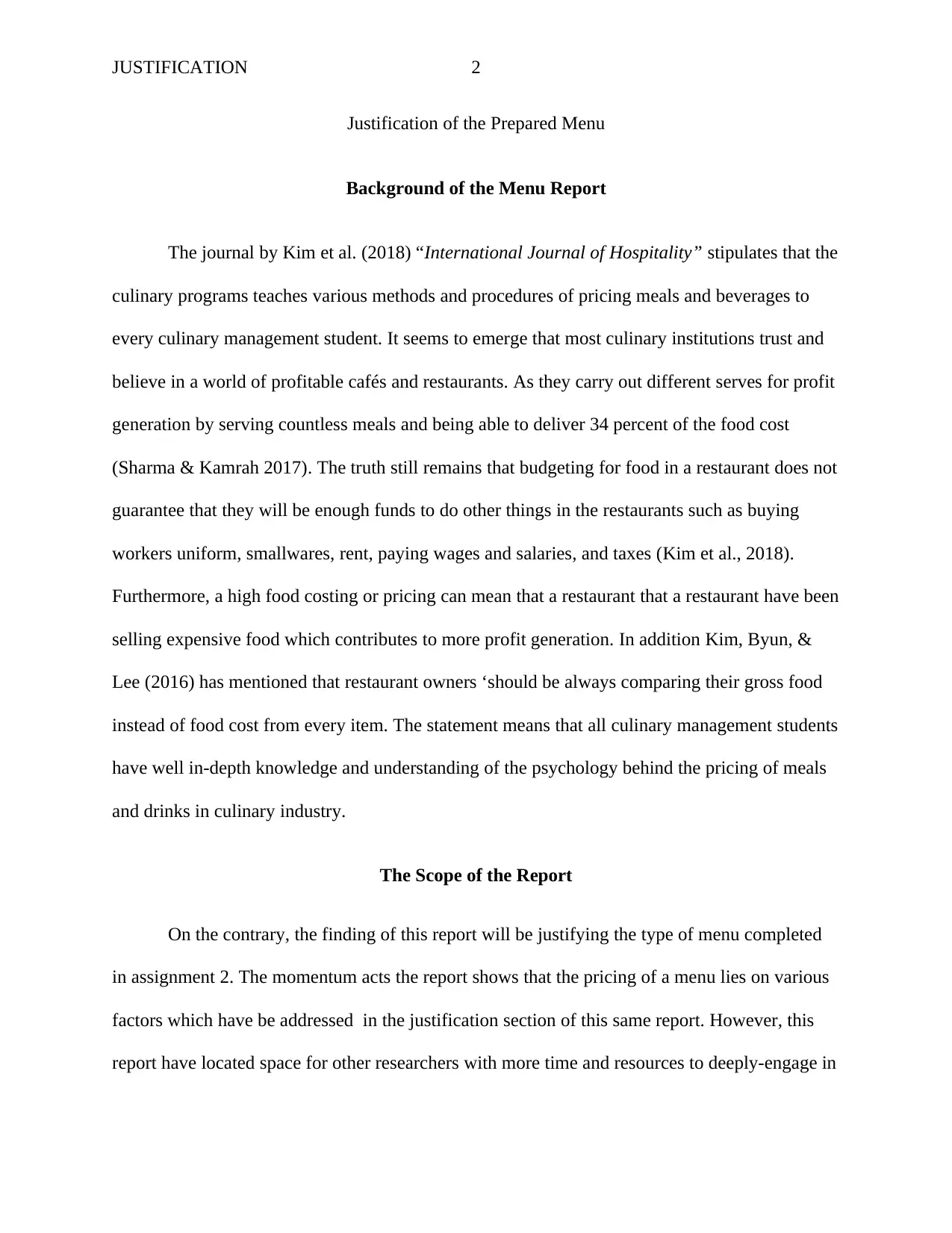
JUSTIFICATION 2
Justification of the Prepared Menu
Background of the Menu Report
The journal by Kim et al. (2018) “International Journal of Hospitality” stipulates that the
culinary programs teaches various methods and procedures of pricing meals and beverages to
every culinary management student. It seems to emerge that most culinary institutions trust and
believe in a world of profitable cafés and restaurants. As they carry out different serves for profit
generation by serving countless meals and being able to deliver 34 percent of the food cost
(Sharma & Kamrah 2017). The truth still remains that budgeting for food in a restaurant does not
guarantee that they will be enough funds to do other things in the restaurants such as buying
workers uniform, smallwares, rent, paying wages and salaries, and taxes (Kim et al., 2018).
Furthermore, a high food costing or pricing can mean that a restaurant that a restaurant have been
selling expensive food which contributes to more profit generation. In addition Kim, Byun, &
Lee (2016) has mentioned that restaurant owners ‘should be always comparing their gross food
instead of food cost from every item. The statement means that all culinary management students
have well in-depth knowledge and understanding of the psychology behind the pricing of meals
and drinks in culinary industry.
The Scope of the Report
On the contrary, the finding of this report will be justifying the type of menu completed
in assignment 2. The momentum acts the report shows that the pricing of a menu lies on various
factors which have be addressed in the justification section of this same report. However, this
report have located space for other researchers with more time and resources to deeply-engage in
Justification of the Prepared Menu
Background of the Menu Report
The journal by Kim et al. (2018) “International Journal of Hospitality” stipulates that the
culinary programs teaches various methods and procedures of pricing meals and beverages to
every culinary management student. It seems to emerge that most culinary institutions trust and
believe in a world of profitable cafés and restaurants. As they carry out different serves for profit
generation by serving countless meals and being able to deliver 34 percent of the food cost
(Sharma & Kamrah 2017). The truth still remains that budgeting for food in a restaurant does not
guarantee that they will be enough funds to do other things in the restaurants such as buying
workers uniform, smallwares, rent, paying wages and salaries, and taxes (Kim et al., 2018).
Furthermore, a high food costing or pricing can mean that a restaurant that a restaurant have been
selling expensive food which contributes to more profit generation. In addition Kim, Byun, &
Lee (2016) has mentioned that restaurant owners ‘should be always comparing their gross food
instead of food cost from every item. The statement means that all culinary management students
have well in-depth knowledge and understanding of the psychology behind the pricing of meals
and drinks in culinary industry.
The Scope of the Report
On the contrary, the finding of this report will be justifying the type of menu completed
in assignment 2. The momentum acts the report shows that the pricing of a menu lies on various
factors which have be addressed in the justification section of this same report. However, this
report have located space for other researchers with more time and resources to deeply-engage in
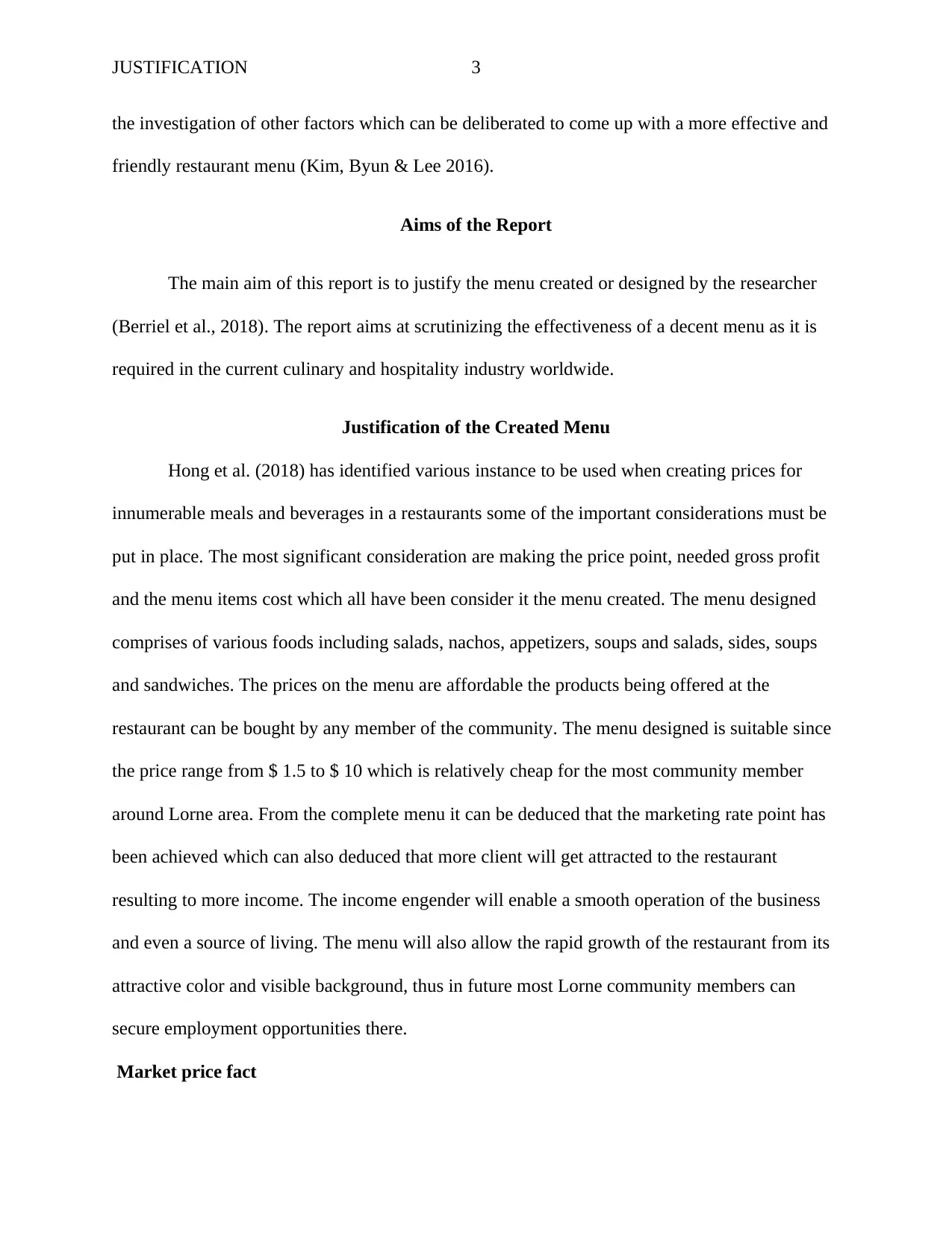
JUSTIFICATION 3
the investigation of other factors which can be deliberated to come up with a more effective and
friendly restaurant menu (Kim, Byun & Lee 2016).
Aims of the Report
The main aim of this report is to justify the menu created or designed by the researcher
(Berriel et al., 2018). The report aims at scrutinizing the effectiveness of a decent menu as it is
required in the current culinary and hospitality industry worldwide.
Justification of the Created Menu
Hong et al. (2018) has identified various instance to be used when creating prices for
innumerable meals and beverages in a restaurants some of the important considerations must be
put in place. The most significant consideration are making the price point, needed gross profit
and the menu items cost which all have been consider it the menu created. The menu designed
comprises of various foods including salads, nachos, appetizers, soups and salads, sides, soups
and sandwiches. The prices on the menu are affordable the products being offered at the
restaurant can be bought by any member of the community. The menu designed is suitable since
the price range from $ 1.5 to $ 10 which is relatively cheap for the most community member
around Lorne area. From the complete menu it can be deduced that the marketing rate point has
been achieved which can also deduced that more client will get attracted to the restaurant
resulting to more income. The income engender will enable a smooth operation of the business
and even a source of living. The menu will also allow the rapid growth of the restaurant from its
attractive color and visible background, thus in future most Lorne community members can
secure employment opportunities there.
Market price fact
the investigation of other factors which can be deliberated to come up with a more effective and
friendly restaurant menu (Kim, Byun & Lee 2016).
Aims of the Report
The main aim of this report is to justify the menu created or designed by the researcher
(Berriel et al., 2018). The report aims at scrutinizing the effectiveness of a decent menu as it is
required in the current culinary and hospitality industry worldwide.
Justification of the Created Menu
Hong et al. (2018) has identified various instance to be used when creating prices for
innumerable meals and beverages in a restaurants some of the important considerations must be
put in place. The most significant consideration are making the price point, needed gross profit
and the menu items cost which all have been consider it the menu created. The menu designed
comprises of various foods including salads, nachos, appetizers, soups and salads, sides, soups
and sandwiches. The prices on the menu are affordable the products being offered at the
restaurant can be bought by any member of the community. The menu designed is suitable since
the price range from $ 1.5 to $ 10 which is relatively cheap for the most community member
around Lorne area. From the complete menu it can be deduced that the marketing rate point has
been achieved which can also deduced that more client will get attracted to the restaurant
resulting to more income. The income engender will enable a smooth operation of the business
and even a source of living. The menu will also allow the rapid growth of the restaurant from its
attractive color and visible background, thus in future most Lorne community members can
secure employment opportunities there.
Market price fact
⊘ This is a preview!⊘
Do you want full access?
Subscribe today to unlock all pages.

Trusted by 1+ million students worldwide
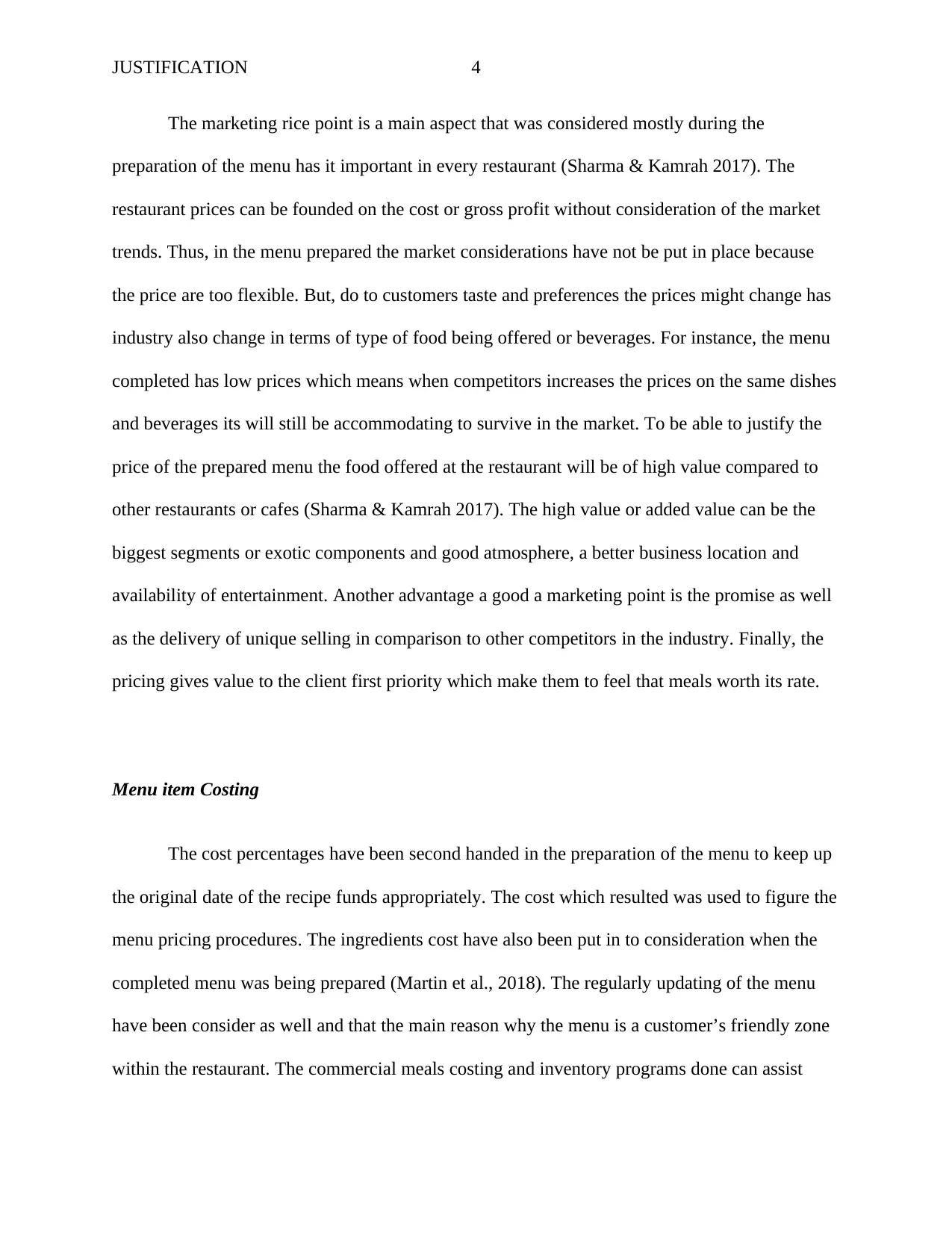
JUSTIFICATION 4
The marketing rice point is a main aspect that was considered mostly during the
preparation of the menu has it important in every restaurant (Sharma & Kamrah 2017). The
restaurant prices can be founded on the cost or gross profit without consideration of the market
trends. Thus, in the menu prepared the market considerations have not be put in place because
the price are too flexible. But, do to customers taste and preferences the prices might change has
industry also change in terms of type of food being offered or beverages. For instance, the menu
completed has low prices which means when competitors increases the prices on the same dishes
and beverages its will still be accommodating to survive in the market. To be able to justify the
price of the prepared menu the food offered at the restaurant will be of high value compared to
other restaurants or cafes (Sharma & Kamrah 2017). The high value or added value can be the
biggest segments or exotic components and good atmosphere, a better business location and
availability of entertainment. Another advantage a good a marketing point is the promise as well
as the delivery of unique selling in comparison to other competitors in the industry. Finally, the
pricing gives value to the client first priority which make them to feel that meals worth its rate.
Menu item Costing
The cost percentages have been second handed in the preparation of the menu to keep up
the original date of the recipe funds appropriately. The cost which resulted was used to figure the
menu pricing procedures. The ingredients cost have also been put in to consideration when the
completed menu was being prepared (Martin et al., 2018). The regularly updating of the menu
have been consider as well and that the main reason why the menu is a customer’s friendly zone
within the restaurant. The commercial meals costing and inventory programs done can assist
The marketing rice point is a main aspect that was considered mostly during the
preparation of the menu has it important in every restaurant (Sharma & Kamrah 2017). The
restaurant prices can be founded on the cost or gross profit without consideration of the market
trends. Thus, in the menu prepared the market considerations have not be put in place because
the price are too flexible. But, do to customers taste and preferences the prices might change has
industry also change in terms of type of food being offered or beverages. For instance, the menu
completed has low prices which means when competitors increases the prices on the same dishes
and beverages its will still be accommodating to survive in the market. To be able to justify the
price of the prepared menu the food offered at the restaurant will be of high value compared to
other restaurants or cafes (Sharma & Kamrah 2017). The high value or added value can be the
biggest segments or exotic components and good atmosphere, a better business location and
availability of entertainment. Another advantage a good a marketing point is the promise as well
as the delivery of unique selling in comparison to other competitors in the industry. Finally, the
pricing gives value to the client first priority which make them to feel that meals worth its rate.
Menu item Costing
The cost percentages have been second handed in the preparation of the menu to keep up
the original date of the recipe funds appropriately. The cost which resulted was used to figure the
menu pricing procedures. The ingredients cost have also been put in to consideration when the
completed menu was being prepared (Martin et al., 2018). The regularly updating of the menu
have been consider as well and that the main reason why the menu is a customer’s friendly zone
within the restaurant. The commercial meals costing and inventory programs done can assist
Paraphrase This Document
Need a fresh take? Get an instant paraphrase of this document with our AI Paraphraser
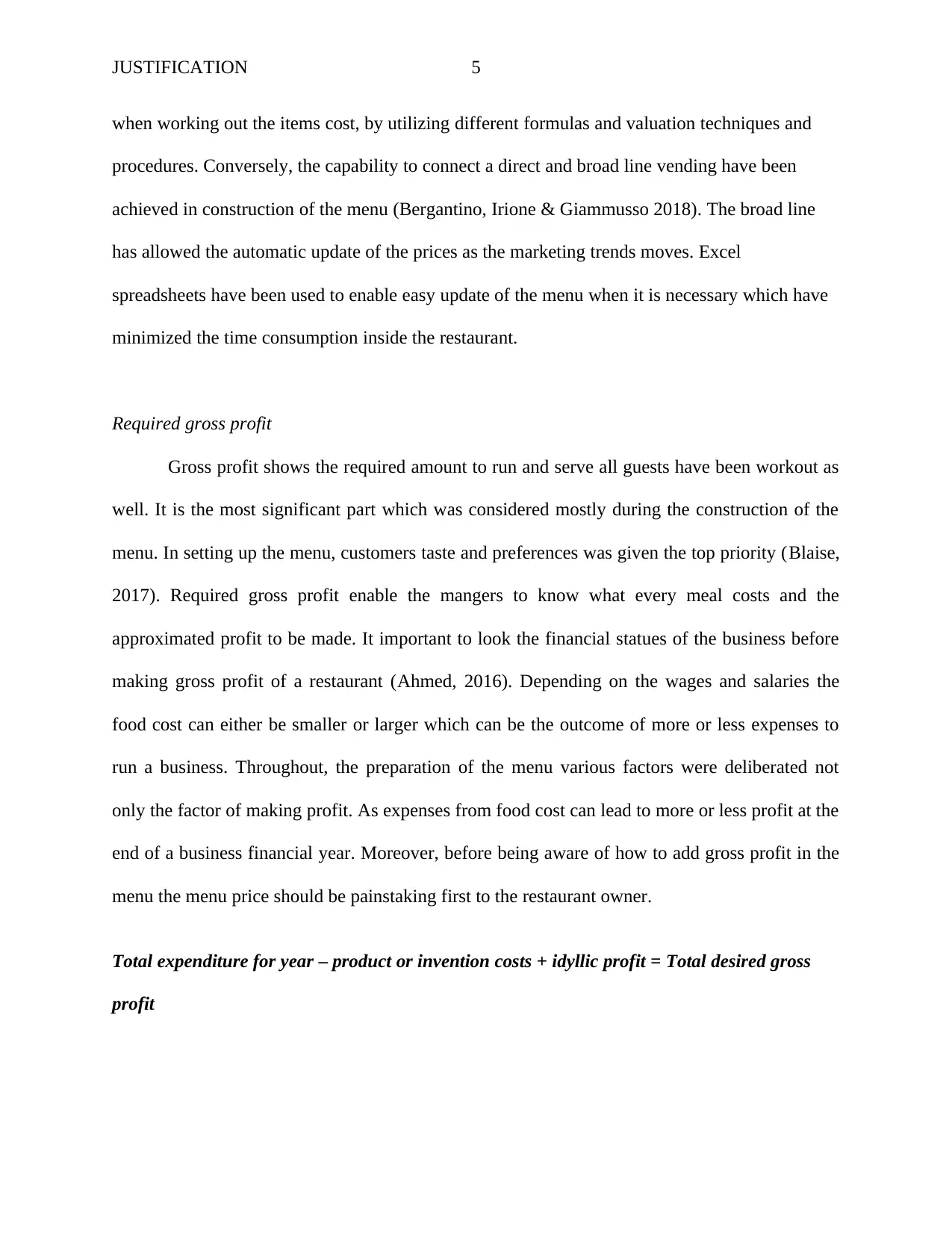
JUSTIFICATION 5
when working out the items cost, by utilizing different formulas and valuation techniques and
procedures. Conversely, the capability to connect a direct and broad line vending have been
achieved in construction of the menu (Bergantino, Irione & Giammusso 2018). The broad line
has allowed the automatic update of the prices as the marketing trends moves. Excel
spreadsheets have been used to enable easy update of the menu when it is necessary which have
minimized the time consumption inside the restaurant.
Required gross profit
Gross profit shows the required amount to run and serve all guests have been workout as
well. It is the most significant part which was considered mostly during the construction of the
menu. In setting up the menu, customers taste and preferences was given the top priority (Blaise,
2017). Required gross profit enable the mangers to know what every meal costs and the
approximated profit to be made. It important to look the financial statues of the business before
making gross profit of a restaurant (Ahmed, 2016). Depending on the wages and salaries the
food cost can either be smaller or larger which can be the outcome of more or less expenses to
run a business. Throughout, the preparation of the menu various factors were deliberated not
only the factor of making profit. As expenses from food cost can lead to more or less profit at the
end of a business financial year. Moreover, before being aware of how to add gross profit in the
menu the menu price should be painstaking first to the restaurant owner.
Total expenditure for year – product or invention costs + idyllic profit = Total desired gross
profit
when working out the items cost, by utilizing different formulas and valuation techniques and
procedures. Conversely, the capability to connect a direct and broad line vending have been
achieved in construction of the menu (Bergantino, Irione & Giammusso 2018). The broad line
has allowed the automatic update of the prices as the marketing trends moves. Excel
spreadsheets have been used to enable easy update of the menu when it is necessary which have
minimized the time consumption inside the restaurant.
Required gross profit
Gross profit shows the required amount to run and serve all guests have been workout as
well. It is the most significant part which was considered mostly during the construction of the
menu. In setting up the menu, customers taste and preferences was given the top priority (Blaise,
2017). Required gross profit enable the mangers to know what every meal costs and the
approximated profit to be made. It important to look the financial statues of the business before
making gross profit of a restaurant (Ahmed, 2016). Depending on the wages and salaries the
food cost can either be smaller or larger which can be the outcome of more or less expenses to
run a business. Throughout, the preparation of the menu various factors were deliberated not
only the factor of making profit. As expenses from food cost can lead to more or less profit at the
end of a business financial year. Moreover, before being aware of how to add gross profit in the
menu the menu price should be painstaking first to the restaurant owner.
Total expenditure for year – product or invention costs + idyllic profit = Total desired gross
profit
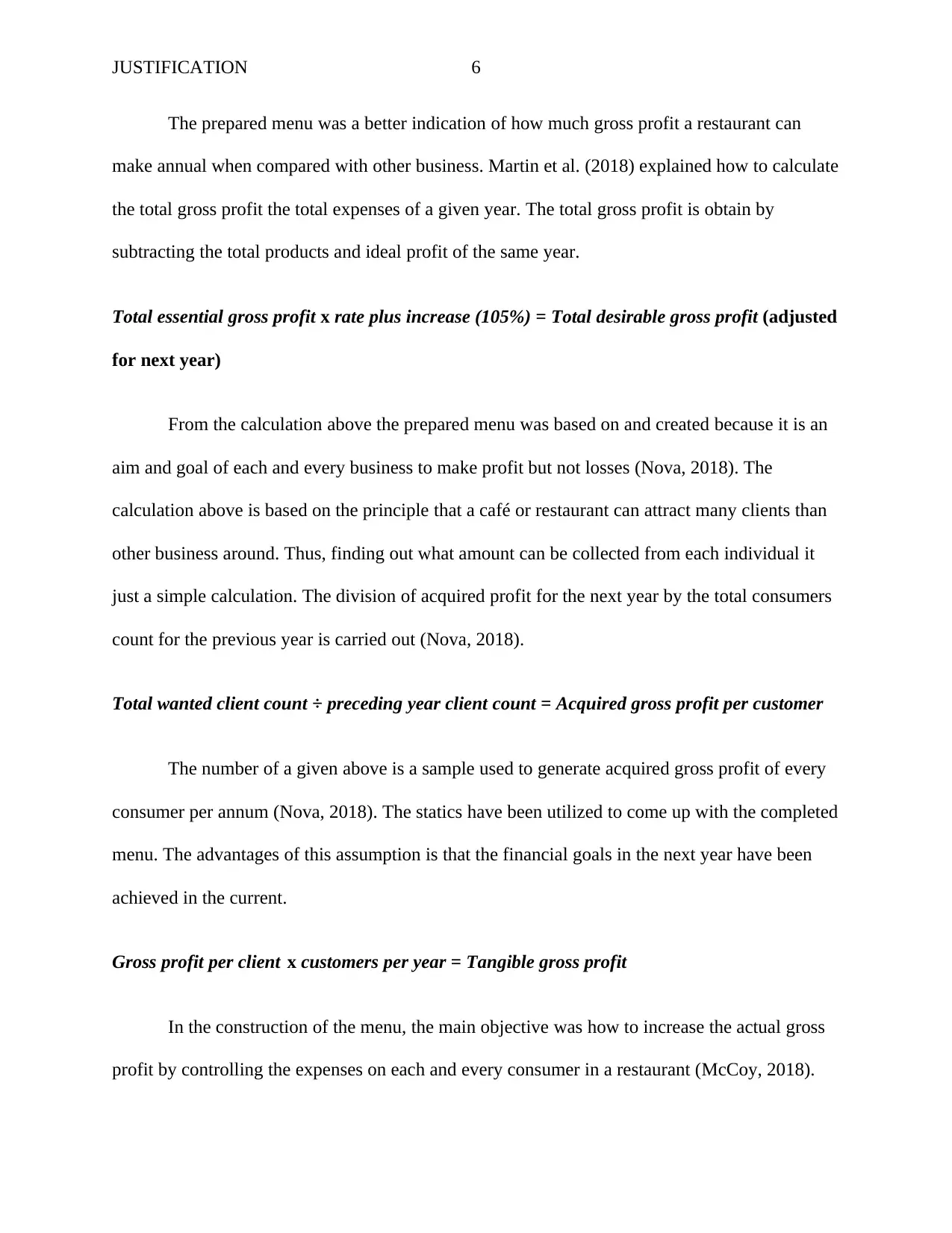
JUSTIFICATION 6
The prepared menu was a better indication of how much gross profit a restaurant can
make annual when compared with other business. Martin et al. (2018) explained how to calculate
the total gross profit the total expenses of a given year. The total gross profit is obtain by
subtracting the total products and ideal profit of the same year.
Total essential gross profit x rate plus increase (105%) = Total desirable gross profit (adjusted
for next year)
From the calculation above the prepared menu was based on and created because it is an
aim and goal of each and every business to make profit but not losses (Nova, 2018). The
calculation above is based on the principle that a café or restaurant can attract many clients than
other business around. Thus, finding out what amount can be collected from each individual it
just a simple calculation. The division of acquired profit for the next year by the total consumers
count for the previous year is carried out (Nova, 2018).
Total wanted client count ÷ preceding year client count = Acquired gross profit per customer
The number of a given above is a sample used to generate acquired gross profit of every
consumer per annum (Nova, 2018). The statics have been utilized to come up with the completed
menu. The advantages of this assumption is that the financial goals in the next year have been
achieved in the current.
Gross profit per client x customers per year = Tangible gross profit
In the construction of the menu, the main objective was how to increase the actual gross
profit by controlling the expenses on each and every consumer in a restaurant (McCoy, 2018).
The prepared menu was a better indication of how much gross profit a restaurant can
make annual when compared with other business. Martin et al. (2018) explained how to calculate
the total gross profit the total expenses of a given year. The total gross profit is obtain by
subtracting the total products and ideal profit of the same year.
Total essential gross profit x rate plus increase (105%) = Total desirable gross profit (adjusted
for next year)
From the calculation above the prepared menu was based on and created because it is an
aim and goal of each and every business to make profit but not losses (Nova, 2018). The
calculation above is based on the principle that a café or restaurant can attract many clients than
other business around. Thus, finding out what amount can be collected from each individual it
just a simple calculation. The division of acquired profit for the next year by the total consumers
count for the previous year is carried out (Nova, 2018).
Total wanted client count ÷ preceding year client count = Acquired gross profit per customer
The number of a given above is a sample used to generate acquired gross profit of every
consumer per annum (Nova, 2018). The statics have been utilized to come up with the completed
menu. The advantages of this assumption is that the financial goals in the next year have been
achieved in the current.
Gross profit per client x customers per year = Tangible gross profit
In the construction of the menu, the main objective was how to increase the actual gross
profit by controlling the expenses on each and every consumer in a restaurant (McCoy, 2018).
⊘ This is a preview!⊘
Do you want full access?
Subscribe today to unlock all pages.

Trusted by 1+ million students worldwide
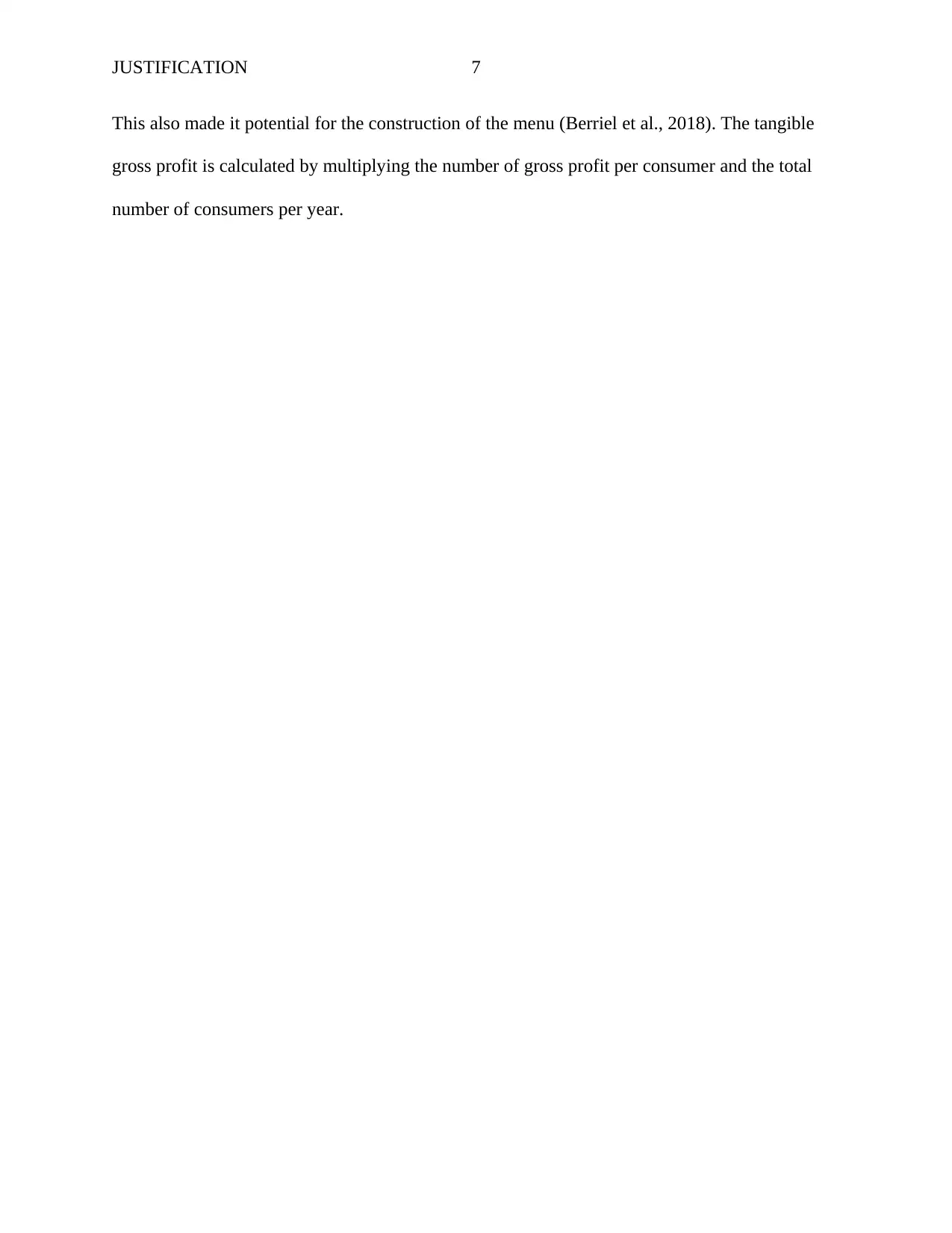
JUSTIFICATION 7
This also made it potential for the construction of the menu (Berriel et al., 2018). The tangible
gross profit is calculated by multiplying the number of gross profit per consumer and the total
number of consumers per year.
This also made it potential for the construction of the menu (Berriel et al., 2018). The tangible
gross profit is calculated by multiplying the number of gross profit per consumer and the total
number of consumers per year.
Paraphrase This Document
Need a fresh take? Get an instant paraphrase of this document with our AI Paraphraser
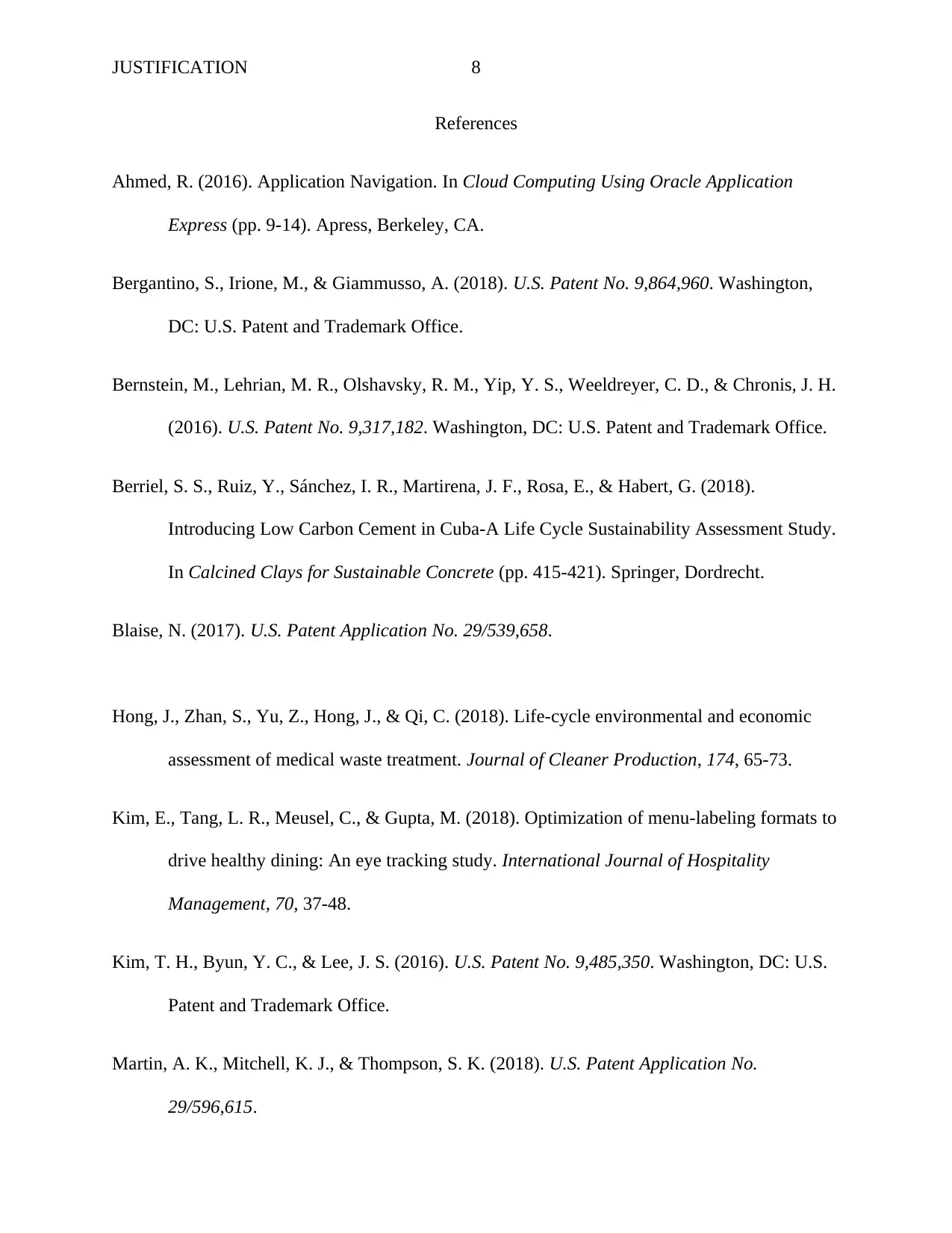
JUSTIFICATION 8
References
Ahmed, R. (2016). Application Navigation. In Cloud Computing Using Oracle Application
Express (pp. 9-14). Apress, Berkeley, CA.
Bergantino, S., Irione, M., & Giammusso, A. (2018). U.S. Patent No. 9,864,960. Washington,
DC: U.S. Patent and Trademark Office.
Bernstein, M., Lehrian, M. R., Olshavsky, R. M., Yip, Y. S., Weeldreyer, C. D., & Chronis, J. H.
(2016). U.S. Patent No. 9,317,182. Washington, DC: U.S. Patent and Trademark Office.
Berriel, S. S., Ruiz, Y., Sánchez, I. R., Martirena, J. F., Rosa, E., & Habert, G. (2018).
Introducing Low Carbon Cement in Cuba-A Life Cycle Sustainability Assessment Study.
In Calcined Clays for Sustainable Concrete (pp. 415-421). Springer, Dordrecht.
Blaise, N. (2017). U.S. Patent Application No. 29/539,658.
Hong, J., Zhan, S., Yu, Z., Hong, J., & Qi, C. (2018). Life-cycle environmental and economic
assessment of medical waste treatment. Journal of Cleaner Production, 174, 65-73.
Kim, E., Tang, L. R., Meusel, C., & Gupta, M. (2018). Optimization of menu-labeling formats to
drive healthy dining: An eye tracking study. International Journal of Hospitality
Management, 70, 37-48.
Kim, T. H., Byun, Y. C., & Lee, J. S. (2016). U.S. Patent No. 9,485,350. Washington, DC: U.S.
Patent and Trademark Office.
Martin, A. K., Mitchell, K. J., & Thompson, S. K. (2018). U.S. Patent Application No.
29/596,615.
References
Ahmed, R. (2016). Application Navigation. In Cloud Computing Using Oracle Application
Express (pp. 9-14). Apress, Berkeley, CA.
Bergantino, S., Irione, M., & Giammusso, A. (2018). U.S. Patent No. 9,864,960. Washington,
DC: U.S. Patent and Trademark Office.
Bernstein, M., Lehrian, M. R., Olshavsky, R. M., Yip, Y. S., Weeldreyer, C. D., & Chronis, J. H.
(2016). U.S. Patent No. 9,317,182. Washington, DC: U.S. Patent and Trademark Office.
Berriel, S. S., Ruiz, Y., Sánchez, I. R., Martirena, J. F., Rosa, E., & Habert, G. (2018).
Introducing Low Carbon Cement in Cuba-A Life Cycle Sustainability Assessment Study.
In Calcined Clays for Sustainable Concrete (pp. 415-421). Springer, Dordrecht.
Blaise, N. (2017). U.S. Patent Application No. 29/539,658.
Hong, J., Zhan, S., Yu, Z., Hong, J., & Qi, C. (2018). Life-cycle environmental and economic
assessment of medical waste treatment. Journal of Cleaner Production, 174, 65-73.
Kim, E., Tang, L. R., Meusel, C., & Gupta, M. (2018). Optimization of menu-labeling formats to
drive healthy dining: An eye tracking study. International Journal of Hospitality
Management, 70, 37-48.
Kim, T. H., Byun, Y. C., & Lee, J. S. (2016). U.S. Patent No. 9,485,350. Washington, DC: U.S.
Patent and Trademark Office.
Martin, A. K., Mitchell, K. J., & Thompson, S. K. (2018). U.S. Patent Application No.
29/596,615.
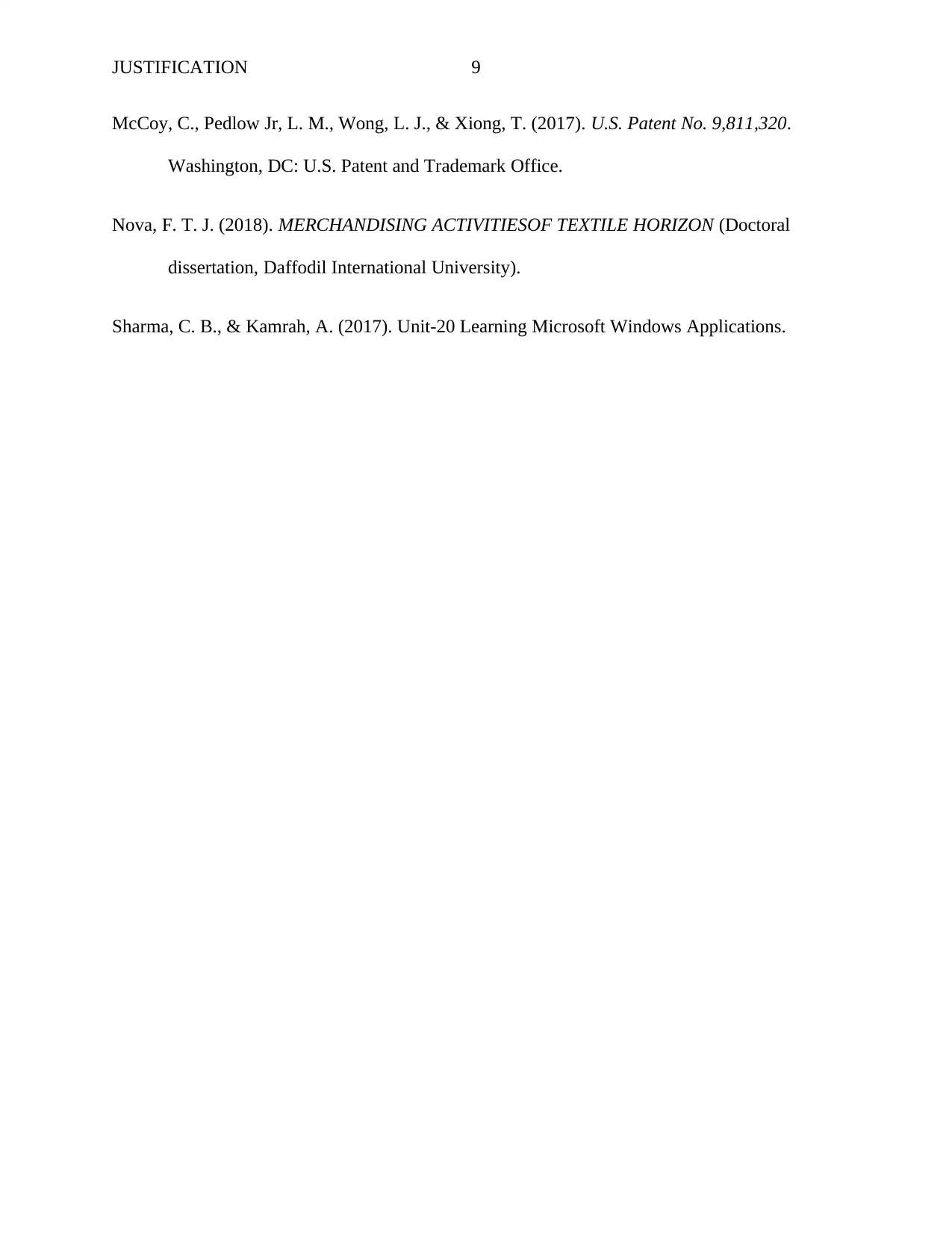
JUSTIFICATION 9
McCoy, C., Pedlow Jr, L. M., Wong, L. J., & Xiong, T. (2017). U.S. Patent No. 9,811,320.
Washington, DC: U.S. Patent and Trademark Office.
Nova, F. T. J. (2018). MERCHANDISING ACTIVITIESOF TEXTILE HORIZON (Doctoral
dissertation, Daffodil International University).
Sharma, C. B., & Kamrah, A. (2017). Unit-20 Learning Microsoft Windows Applications.
McCoy, C., Pedlow Jr, L. M., Wong, L. J., & Xiong, T. (2017). U.S. Patent No. 9,811,320.
Washington, DC: U.S. Patent and Trademark Office.
Nova, F. T. J. (2018). MERCHANDISING ACTIVITIESOF TEXTILE HORIZON (Doctoral
dissertation, Daffodil International University).
Sharma, C. B., & Kamrah, A. (2017). Unit-20 Learning Microsoft Windows Applications.
⊘ This is a preview!⊘
Do you want full access?
Subscribe today to unlock all pages.

Trusted by 1+ million students worldwide
1 out of 9
Related Documents
Your All-in-One AI-Powered Toolkit for Academic Success.
+13062052269
info@desklib.com
Available 24*7 on WhatsApp / Email
![[object Object]](/_next/static/media/star-bottom.7253800d.svg)
Unlock your academic potential
Copyright © 2020–2025 A2Z Services. All Rights Reserved. Developed and managed by ZUCOL.





